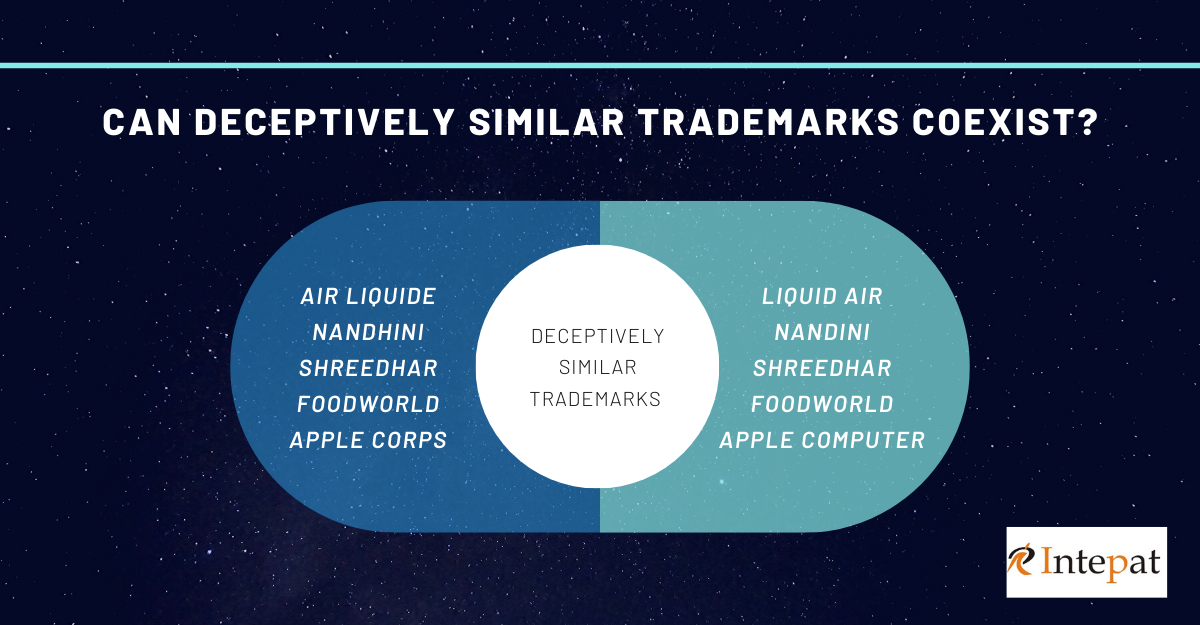Deceptive Similar Trademarks
The primary basis of trademark protection, as an intellectual property right, is that it is a sign, which is capable of distinguishing the goods or services of one person from those of another. However, due to that very nature, ambiguities arise on whether similar trademarks can be registered if the goods/ services are from different classes.
L’AirLiquideSocieteAnonyme pour l’etude et l’exploitation desprocedes Georges Claude and Anr v. Liquid air & Ors. was a case wherein the courts provided clarity on the issue. In the instant case, the plaintiff had alleged that the trademark of the defendant was deceptively similar to the mark of the plaintiff, i.e., Liquid Air. The plaintiffs are one of the leading manufacturers of industrial gases, and their business spans across various countries. They commenced their business in 1902 and operated under classes 1, 6, 10, and 11. The defendants, on the other hand, are distributors of industrial gasses and operate under class 39.
The plaintiffs alleged that the marks used by defendants were identical/deceptively similar to the plaintiff’s mark, and there was a clear correlation between their fields of businesses, which would confuse the general public. The primary contention of the defendants was that their firm had been registered in 1995, and they operated in a completely different class from the class that the plaintiffs worked. It was argued that they are involved in the trading of gas products and not in the manufacturing of gases.
However, the court was of the view that the use of the mark by the defendant amounted to infringement even though both parties operated in different classes. This was primarily because the plaintiff was the manufacturer of industrial gasses, and the defendant was the distributor of industrial gases. Therefore, even though the classes were different, the business of the defendant was allied to the industry of the plaintiff, which would, in turn, result in deceptive similarity asserting the goods/ services of one enterprise for that of another.
Similar Trademarks In Different But Interrelated Classes
An exception to Section 28 of the Trade Marks Act provides for situations in which there are contending registered proprietors of similar trademarks, and neither can claim exclusivity over the said trademark. However, an ambiguity, which arises concerning this, is whether the exception is only available for goods of that class or whether it can be applied to goods of other classes as well.
In the case of Kumar Milk Foods v. Vikas Tyagi (CS (OS) No. 1627 of 2011), the plaintiff operated under Class 29 for ‘milk products, ghee, etc.’ and had a registered trademark ‘Shreedhar.’ The defendants operated under Class 30 for ‘atta, maida, etc.’ and were also registered proprietors of the trademark ‘Shreedhar.’ However, it was found that the defendants had begun to operate in Class 29 for manufacturing various milk products.
The court held that since different classifications of goods had been provided, the exception, i.e., both registered proprietors would not be able to claim exclusivity over the marks, would apply to two conditions. First, the two registered trademarks should be identical or should nearly resemble each other. Second, the two should be in relation to the same class of goods and services. Therefore, broadly, similar trademarks could be allowed till the time they are in different classes, and proprietors of similar trademarks could claim mutual exclusivity only when there is a similarity in the class of goods and services.
In the case of Foodworld v. Foodworld Hospitality Pvt. Ltd. 2010 (42) PTC 108(Del.), the court had held that if the two particular enterprises did not enter each other’s fields of business, they could be allowed the use of similar trademarks. However, the same would not be permitted if there was an overlap in the area of activity of the proprietors of the registered trademark. Therefore, in order to ascertain mutual exclusivity, the commonality in the field of business was an important aspect, which should be looked into.
Trademark Coexistence
Another situation wherein similarity within trademarks subsists that of trademark coexistence. Trademark coexistence agreements come into existence when two enterprises use similar trademarks but without interfering in the business of the other. This coexistence is based upon the principle of good faith wherein the companies to ensure that they have a record of the real use of their marks and do not infringe upon the rights of the other. However, most often, these agreements do not sustain as even in good faith; factors such as business expansion may bring the two or more enterprises into conflict. An example of this is between Apple Corps and Apple Computer, which came into a coexistence agreement; however, due to business expansion in the later stages, it fell into conflict.
It has been emphasized that a similar trademark may not be used for a common field of activity or where there is an overlap between the businesses of the registered proprietors. However, it is also essential to note that having a common area of action is not conclusive for determining whether similarity in trademarks would result in passing off. It can occur in cases of goods that are allied to the business of the registered proprietor in another class, as was seen in the case of L’AirLiquideSocieteAnonyme pour l’etude et l’exploitation desprocedes Georges Claude and Anr v. Liquid air & Ors. The question, which courts try to determine, pertains to the aspects of misrepresentation, a real likelihood of confusion or deception to the public, and ultimately the damages which are borne as a consequence to such similarity within trademarks, which decides whether similar trademarks within different classes can coexist.




